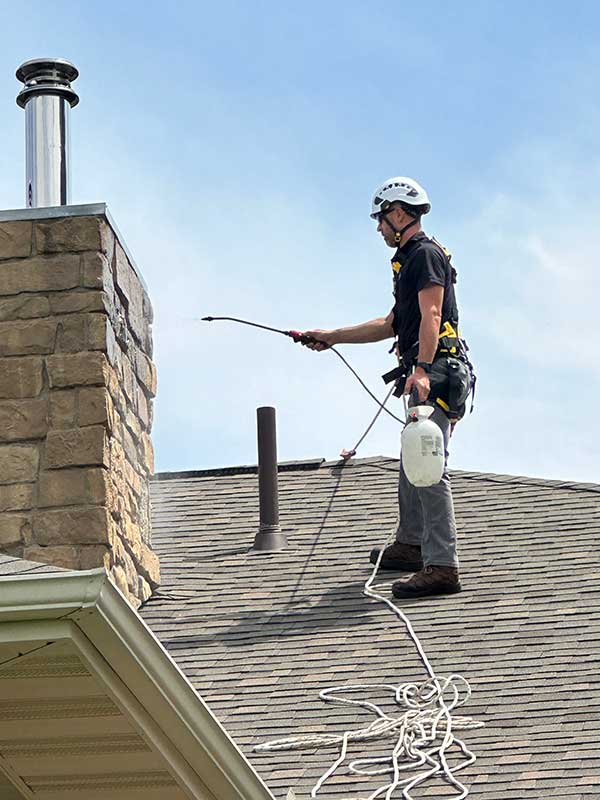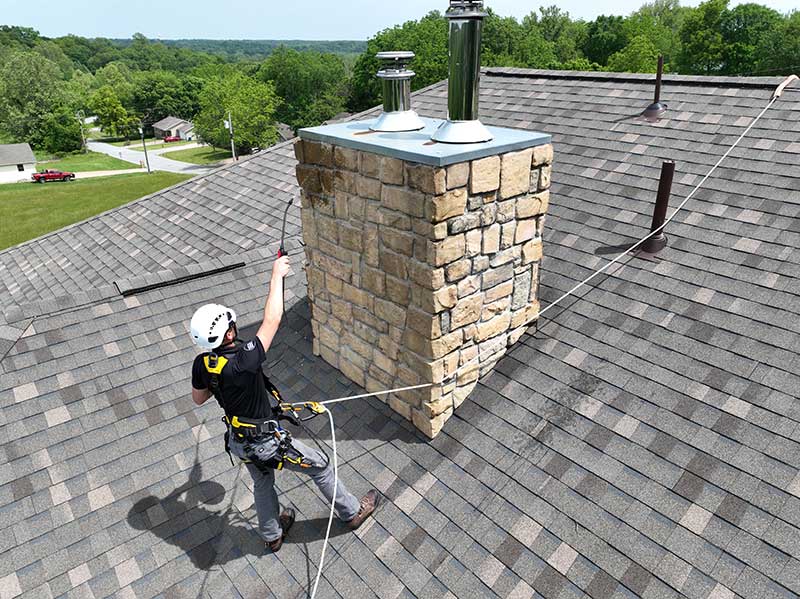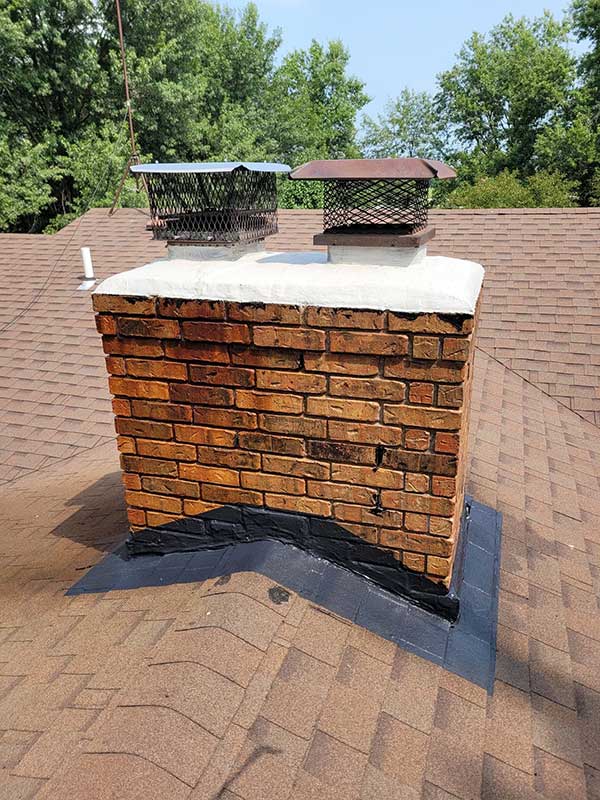Protect Your Chimney Against Water Damage With Chimney Waterproofing
Did you know that water is a chimney’s worst enemy? These systems may look indestructible, but over time, water damage can become a number one issue, causing all kinds of damage and wreaking havoc through the system – and your home too.
In fact, problems like rusting on the chimney cap and damper, mold and mildew growth, crumbling mortar, and cracked bricks can directly result from unresolved chimney leaks. Because of this, it’s important to take a proactive approach when caring for your chimney by investing in annual inspections and regular sweepings. You can also protect your chimney against water damage with another weapon – waterproofing.
If you’re a homeowner in the Southwest Missouri or Northwest Arkansas areas, schedule a waterproofing appointment with Ozark Stove & Chimney today – and potentially save yourself a lot of money in the long run.
Why Should I Waterproof My Chimney?
Waterproofing is a preventive measure that can protect your chimney against the natural elements and trust us – the best course of action against water damage and chimney leaks is prevention, hands down.
Waterproofing not only shields your chimney against moisture, but it can also provide other benefits. A chimney that is waterproofed is less likely to break down, and the system will last longer, too, because the natural outdoor elements that are known to affect the structure’s overall integrity won’t have easy access.
Waterproofing also protects against the freeze/thaw process. What is this?
In the Ozarks, fall and winter can bring on cold and damp weather. That’s bad news for your chimney. During storms, rain, snow, and ice accumulate on the exterior brick surface. Since brick is porous by nature, it absorbs this water. As temperatures drop, the water freezes and expands, eventually causing bricks and mortar to crack. When the ice melts during the warmer parts of the day, larger cracks and voids are left behind to absorb even more moisture the next time there is an adverse weather event.
This freeze/thaw cycle repeats multiple times a season, year after year. After some time, you may start to notice more instances of crumbling mortar and brick spalling. If this level of water damage goes uncorrected, it can lead to serious issues for your chimney, like structural instability, which is expensive and time-consuming to fix.

What if My Chimney Isn’t Leaking… Should I Still Waterproof?
Yes. In fact, it may be more of a reason to do so, ensuring you continue avoiding leaks and water damage!
In the end, just because you may not have had issues with leaks or water damage in the past, doesn’t guarantee your chimney is safe from future problems. In its early stages, water damage may be hard to identify and problems can go undetected for months. A chimney cap alone is not always enough to protect against moisture, and it won’t stop your bricks from soaking it in. The same with flashing and other preventive structural components.
In addition, caps, flashing, crowns, and the like can crack, deteriorate, or be damaged by strong winds during a storm, so you might not be as protected as you think. It’s hard to know what’s happening up on your roof!
The best way to make sure your chimney is protected from future problems is to have your chimney inspected every year and to invest in preventive measures, like waterproofing. Don’t wait until a problem arises to give us a call. Dial 417-201-6585 or schedule a service online now.

Can I Waterproof My Chimney Myself?
You can attempt to waterproof your chimney by yourself, sure… but it isn’t recommended. Our chimney technicians are trained and Chimney Safety Institute of America (CSIA)-certified to spot brickwork issues that may be missed by an inexperienced eye. In addition, most products you can gain easy access to (i.e. products that aren’t industry grade) won’t last as long, so you’ll have to reapply them time and time again in order to maintain their effectiveness.
While it’s easy to buy products online and in-store yourself (and it may seem like the most cost-effective option), we know exactly which products will get the job done and how to apply them so that they are maximally effective.
In addition, vapor permeability is a must when it comes to waterproofing, and not all products offer this. Trust us from the start, so you can rest easier knowing the job was done right.
How Long Does Chimney Waterproofing Last?
On average, waterproofing that is applied properly can last between five and 10 years. This can vary based on regional weather conditions, how often you use your chimney, and its overall condition. Reapplications may be needed more frequently depending on the type of waterproofing you originally had done.
What Is the Most Common Cause of Chimney Leaks?
We wish we could give you one solid cause of chimney leaks, along with a clearcut guide for defending against it, but the truth about your chimney and water-related issues isn’t so simple and straightforward. There are actually quite a number of things that can cause your chimney to leak, so avoiding problems isn’t always so cut and dry (pun intended).
The good news is that, by recognizing possible entry points for water, you can take proactive steps towards protecting your home.
So, what are some of the most common ways that water gets into chimneys?
Lack of Waterproofing
We’ve been talking a lot about waterproofing, so this shouldn’t come as a big surprise… Waterproofing is a must when it comes to preventing leaks. Bricks are made of a soft and porous material called clay, and during the brick-making process, a waterproof outer shell is baked in to prevent the bricks from soaking up water. Unfortunately, continuous exposure to changing weather patterns can eventually break down the outer layer of the bricks – and the waterproof protectant right along with it.
If the shell isn’t replaced with a protective sealant, the bricks can absorb water and begin to break down over time leading to a leaky chimney and home damage. Unchecked, this can lead to a compromised flue, rusted metal components, mold/mildew growth, and an array of other problems.
Damaged Crown
Your chimney crown can naturally deteriorate due to wear and tear. It becomes susceptible to minor and significant cracks as it is exposed to weather and the elements over time. Minor cracks can be patched with a sealant, but larger cracks require a bit more work.
In a scenario where a chimney crown has sustained a large crack, a technician will fill the damaged areas with high-bond patching material and finish it off with a – surprise – waterproof sealant. The sealant will prevent the chimney crown from absorbing water.
Damaged Flashing
Chimney flashing is comprised of thin metal strips that are installed around the base of a chimney, right where it meets the roof. If the flashing is damaged, water can penetrate the chimney’s brick exterior and potentially damage mortar joints, interior wood, insulation, and sheetrock. Signs of a leaking chimney may get worse after rain or other instances of severe weather, so be on the lookout and call us in if you’re concerned.
Damaged or Missing Chimney Cap
A chimney cap is one of the most important parts of your chimney. It sits at the top of your chimney, right above the chimney crown, and it keeps out debris, blocks the pathway of curious animals, and prevents water from getting into the interior. If the chimney cap is missing or damaged, your chimney will be exposed to moisture and will face damage as a result.
Spalling Brick & Missing Mortar
Missing mortar joints are a common problem for masonry chimneys. Mortar joints hold the bricks together and help keep moisture from entering the chimney system. When joints are deteriorating or missing, water can get into your chimney and home, leading to serious water damage.
Like bricks, mortar is a porous material and absorbs water. As time goes on, the mortar will begin to disintegrate, and it is especially vulnerable in cold weather areas where the freeze/thaw cycle is a major concern. Again – waterproofing can save the day when it comes to preventing deterioration throughout this part of your chimney.
Types of Damage Caused by Chimney Leaks
It can be difficult to detect the signs of chimney leaks until the damage is too far gone and the price to repair it has gone up. But, there are a few telltale signs that your chimney may have a water problem:
- Unusual chimney odors (likely caused by creosote buildup and/or mold and mildew growth)
- Rusted damper assemblies
- Deteriorating metal or masonry firebox assemblies
- Rusted fireplace accessories
- Wood framing that is rotting
- Stained chimney exteriors
- Water-damaged walls and ceilings near the chimney
- Deteriorating exterior mortar joints
- Cracked or damaged flue lining system
- Collapsing hearth support
- Leaning chimney structure
- Chimney separation
- Efflorescence (a white, chalky residue on the brickwork surface that signals water has breached the chimney structure.)

What Should I Do if I Have a Chimney Leak?
If you suspect that you have a chimney leak, the first step is to give us a call at Ozark Stove & Chimney. One of our CSIA-certified technicians will come out for a scheduled chimney inspection. During the inspection, the technician will carefully assess your chimney for signs of water penetration and water damage. If they see any indications of water damage, they will rely on their years of training and hands-on experience to pinpoint entry points and provide a plan to take care of the problem.
Based on our technicians’ findings, possible remedial recommendations can include:
- Waterproofing
- A new chimney cap
- A chase cover or crown repair/replacement
- Flashing repair or replacement
- Tuckpointing or other masonry repairs
Is There Any Way To Prevent Chimney Leaks?
Why yes – in fact, waterproofing is a great way to help fight against water damage! But, like with any chimney maintenance, just one service alone can’t do it all. The good news is that there are other precautions you can take in addition to waterproofing to protect your property from chimney leaks.
- Invest in a Good Chimney Cap: Without a cap at the top of each flue, the flue is unprotected against water penetration and leaks. A chimney cap is fitted pieces of metal that aids in preventing rain, snow, animals, and other debris from getting into your chimney vent. These are relatively inexpensive and quick to install, but it is important that they are sized properly and made of corrosion-resistant materials. Trust us for a job done right.
- Make Sure Your Flashing Is Water-Sealed: Flashing is found at the point where your chimney and roof meet – a spot known for being vulnerable to water leaks and damage. Its primary purpose is to create a waterproof seal that protects your roof, interior walls, and chimney from water penetration. Flashing can be made of different materials including aluminum, steel, copper, vinyl, or polyvinyl chloride (also referred to as PVC).
- Keep an Eye on Mortar Joints & Brick: Chipped or deteriorating mortar and brick are troubling signs of existing chimney issues. If your brick and mortar are showing signs of damage, it usually indicates that your chimney is either vulnerable because water can enter through existing cracks in the brick or the chimney has already been affected by water damage and is deteriorating as a result.
- Book Chimney Crown or Chase Cover Maintenance: A properly functioning chimney crown or chase cover protects against water damage and penetration in the area between the flue and the masonry, metal, or wood surround. These chimney components are often overlooked or have issues stemming from poor craftsmanship. It is important to keep regularly scheduled inspections to detect any early signs of deterioration or weather-related damage.
- Get a Cricket Installed: If your chimney is 30 inches or wider, you should look into installing a chimney cricket. The purpose of the cricket is to prevent water from pooling around the flashing. A cricket will help redirect the water away from your chimney and roof’s intersection and deflect it off of the roof.
Are Chimney Leaks Covered by Homeowner’s Insurance?
If you have a leak in your chimney, repairs for it can add up quickly. But wait… shouldn’t this all be covered by your homeowner’s insurance policy?
Well… it might be! It simply depends on your specific policy and its specific conditions regarding chimneys and any related damages. We will say that typically coverage depends more on whether or not the damage was avoidable. In other words… Was it caused by neglect on your end or was it a “sudden occurrence?”
In most cases, you will have to prove that the leak is the result of a severe weather event – like an earthquake, flood, or hurricane. It is less likely that your homeowner’s insurance will foot the bill if your chimney leak is the result of an ongoing problem or negligence. This is why it is important to take preventive measures in chimney care by investing in waterproofing and regular inspections, and by tending to minor issues in a timely manner.
We’re Here To Help
Before proceeding with waterproofing, it is crucial to have your chimney thoroughly inspected, swept, and, if needed, repaired. Waterproofing will not work if underlying leak-related damages are not addressed.
If you suspect your chimney has a leak and you have concerns about water damage, an inspection can get to the bottom of what is causing your leaks. Give us a call at 417-201-6585 or schedule an appointment online to get started.
When it comes to chimney leak repairs, being sure your chimney cap is installed properly and is in good shape is a must.
